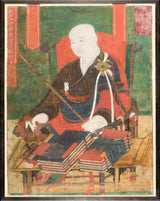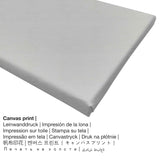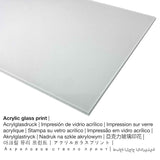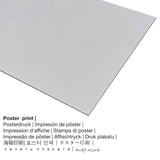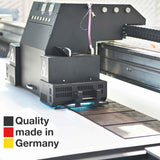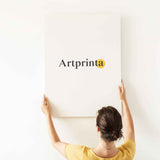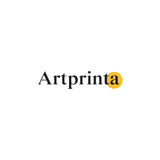Amaghị aha, 1800 - Eserese nke ụkọchukwu Pyeongwondang - ọmarịcha nka.
Ụtụ gụnyere. Mbupu gbakọrọ na ndenye ọpụpụ.
General information as provided from the museum (© Copyright - Los Angeles County Museum of Art - www.lacma.org)
After the death of a Buddhist patriarch, his portrait was often painted to pay tribute to him. These portraits, called jinyeong, also symbolized the long history of succession within the sect, thus strengthening the legitimacy and authority among followers. Often, the portraits themselves became subjects of worship. Many temples housed portraits of the first patriarch of the different schools of Buddhism, well-known monks familiar with the doctrinal studies of Buddhism, and monks who benefited the country. The inscription in the upper left corner of this painting gives the name of the subject, Pyeongweondang Jinyeong. This is the only known portrait of this Buddhist patriarch, and his deeds and accomplishments are as yet unidentified. Praise for Pyeongweondang might once have been written in the red rectangle at the top right; however, the inscription is no longer legible. Typical of the genre, the floor mat and wall create a divided background. Pyeongweondang, facing left, sits in a low chair. In his left hand, he holds a Buddhist wooden staff (Sanskrit: khakkhara) and, in his right hand, he holds Buddhist prayer beads (det. 1). On the low table in front of him are ten sutras, two scrolls, and writing implements including a brush, ink stone, and ink (det. 2). A transparent lidded container sits atop one stack of sutras. Pyeongweondang’s face is unwrinkled and his lips are pursed (det. 3). The artist used a complex painting technique: he first applied white paint to the back of the silk for the face, and then thinly applied an ocher hue from the front. Most of the original color has since been lost. It appears that the robe’s white knot, below the patriarch’s right shoulder, was repainted. The overall composition and color scheme, as well as the subject’s pose, indicate that the portrait was created at the end of the nineteenth century. Read more (Curator Notes)
Product nkọwa
The modern art masterpiece was created by the painter amaonye in 1800. The over 220 year-old original had the size of 43 3/8 x 28 7/8 na (110,17 x 73,34 cm) ma were ihe osise ese Usoro panel, ink and color on silk. What is more, the artwork is part of the collection of Ebe ngosi nka nke Los Angeles County. We are pleased to mention that the masterpiece, which belongs to the public domain is provided with courtesy of Ụlọ ihe ngosi nka nke Los Angeles County (www.lacma.org).Kridi n'obi nke artpiece bụ ndị a: . Kedu ihe ọzọ, nhazi ahụ dị na Eserese format na a akụkụ ruru nke 1: 1.2, nke pụtara na ogologo 20% dị mkpụmkpụ karịa obosara.
Họrọ ụdị ngwaahịa ngwaahịa gị
The product dropdown menu gives you the possibility to choose your prefered material and size. You can choose your your favorite size and material among the following options:
- Mbipụta iko acrylic (nke nwere ezigbo mkpuchi iko): A glossy acrylic glass print, which is often named as a print on plexiglass, will convert your favorite original artwork into beautiful wall décor and offers a viable alternative option to canvas or aluminium dibond fine art replicas. With an acrylic glass fine art print contrasts and also granular artwork details become more exposed because of the subtle gradation. Our real glass coating protects your selected art replica against light and external influences for many years.
- Mbipụta ọla (aluminium dibbond): An Aluminium Dibond print is a print with an outstanding depth effect - for a modern impression and non-reflective surface. A direct Direct Print on Aluminum Dibond is your best start to fine art prints on aluminum. The white & bright components of the work of art shine with a silky gloss but without glare. The colors are vivid and luminous in the highest definition, the details are crisp and clear.
- Akwụkwọ mmado ebipụtara (akwa akwa akwa): The poster print is a printed canvas with a slight surface texture, that reminds the actual masterpiece. Please keep in mind, that depending on the absolute size of the poster print we add a white margin of approximately 2-6cm around the artwork in order to facilitate the framing with a custom frame.
- Kwaaji: The canvas print, which should not be mistaken with a canvas painting, is a digital replica printed directly on canvas. A canvas print of your favorite work of art will allow you to transform your customized art print into a large size work of art like you know from art galleries. Canvas Prints have the advantage of being low in weight, meaning that it is easy to hang your Canvas print without the support of additional wall-mounts. That is why, a canvas print is suited for any kind of wall.
Ozi ndabere na onye na-ese ihe
| Aha onye nka: | amaonye |
| Ọrụ: | onye na-ese ihe |
| Nkewa onye nka: | omenkà nke oge a |
Iberibe ozi ndabere nka
| Aha ọrụ nka: | "Portrait of Priest Pyeongwondang" |
| Nhazi nka: | sere |
| Otu izugbe: | nkà nke oge a |
| Time: | 19th narị afọ |
| Emepụtara n'afọ: | 1800 |
| Afọ nka: | ihe karịrị afọ 220 |
| Agba na: | panel, ink and color on silk |
| Nha izizi: | 43 3/8 x 28 7/8 na (110,17 x 73,34 cm) |
| Egosiputara na: | Ebe ngosi nka nke Los Angeles County |
| Ebe ngosi nka: | Los Angeles, California, Njikota Obodo Amerika |
| website: | Ebe ngosi nka nke Los Angeles County |
| Ikikere nke ihe osise: | ngalaba ọha |
| Site n'aka: | Ụlọ ihe ngosi nka nke Los Angeles County (www.lacma.org) |
Ozi ederede ahaziri
| Nkewa edemede: | ọrụ mgbidi |
| Usoro mmeghari: | mmeputakwa n'ụdị dijitalụ |
| Produzọ mmepụta: | Mbipụta UV ozugbo (mbipụta dijitalụ) |
| Production: | German mere |
| Stockdị ngwaahịa: | a na-achọ |
| Eji ngwaahịa a chọrọ: | mgbidi mgbidi, mgbidi ịchọ mma |
| Nhazi nka nka: | usoro eserese |
| Ụdị anya: | 1:1.2- ogologo: obosara |
| Nsonaazụ nke oke onyonyo: | ogologo bụ 20% mkpụmkpụ karịa obosara |
| Ụdị ihe dị iche iche: | ígwè ebipụta (aluminium dibond), acrylic glass print (nwere ezigbo mkpuchi iko), mbipụta akwụkwọ mmado (akwụkwọ kwaaji), akwụkwọ akwa akwa. |
| Mpempe akwa akwa (akwa akwa na etiti ihe ndọtị) nha: | 50x60cm - 20x24", 100x120cm - 39x47" |
| Acrylic glass print (nwere ezigbo mkpuchi iko) nhọrọ: | 50x60cm - 20x24", 100x120cm - 39x47" |
| Mpempe akwụkwọ mmado (akwụkwọ kwaaji) nha dị iche iche: | 50x60cm - 20x24", 100x120cm - 39x47" |
| Nhọrọ nha mbipụta aluminium dibond: | 50x60cm - 20x24", 100x120cm - 39x47" |
| ụba: | enweghị etiti |
Nkwupụta iwu: We try our utmost in order to depict the products as clearly as it is possible and to display them visually in our shop. Please keep in mind that the pigments of the printed materials and the printing can vary to a certain extent from the presentation on your device's screen. Depending on the screen settings and the condition of the surface, not all color pigments are printed one hundret percent realistically. Considering that all our art prints are printed and processed manually, there might also be slight deviations in the exact position and the size of the motif.
Enwere ikike nwebiisinka ©, www.artprinta.com (Artprinta)

